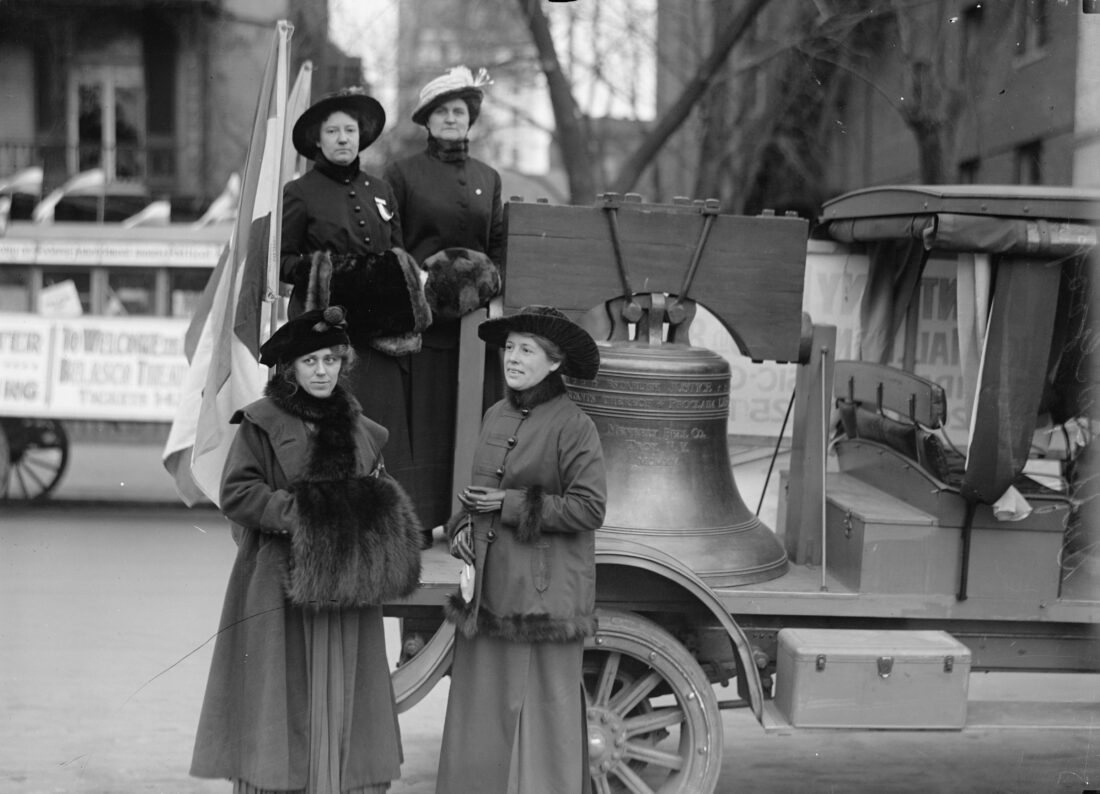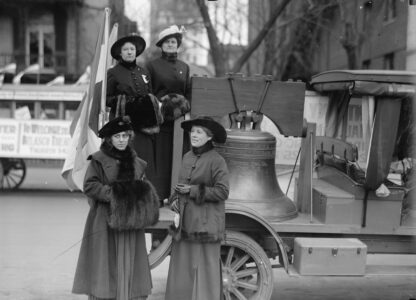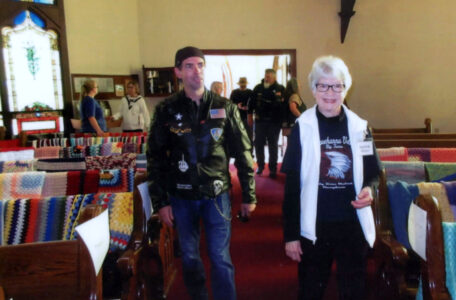Bell a symbol of fight for women’s voting rights

PHOTO VIA LIBRARY OF CONGRESS Top: Women stand by the Justice Bell as it traveled as a symbol of women’s suffrage movement in 1916.
In 1915, women across the country were seeking to be granted the right to vote, a right, at that point, only granted to their male counterparts.
To whip up support for the women’s suffrage movement, a group of women in Pennsylvania got together and decided to have a replica of the Liberty Bell crafted from bronze. The only difference would be that this bell would have the words “Establish Justice” emblazoned on it. The clapper would also be secured so that the bell would not ring until women were granted the right to vote.
During the summer that year, the bell travelled throughout the state. The men were scheduled to vote in November on a referendum to allow women the vote, so to get their message out, an entourage of women accompanying the 2,000 pound bell visited nearly every county, including Lycoming.
The summer had been wet and the women slogged their way around the state, according to Amanda Owen, filmmaker and Executive Director of the Justice Bell Foundation, who has done extensive research on the bell. Owen was a featured speaker at the Taber Museum recently.
“It was the rainiest summer in a decade. Can you imagine those women in those dresses traveling with this bell truck,” Owen asked those attending the presentation.
“Humidity in the summer was in the 90s, there was torrential rain. A lot of the roads were dirt roads that turned to mud and they traveled for almost five months. They missed only three counties. They planned to go through all of them, but they ultimately did not go to Elk County, Cameron County and Schuylkill County,” Owen said.
Everyone wanted the bell to come to their area, she said, and newspaper accounts from the time cited women who travelled to other counties just to see it.
“There was so much rain. On August 3, 1915 Erie experienced a once in 100-year flood. That’s how much rain was coming down in Pennsylvania,” Owen said.
Accounts from that time that Owen found in her research talked about the exhaustion the women felt speaking to thousands of people from the back of the truck with no microphones.
“These were always very planned big affairs. Children would come out with little white dresses. Most of the women had sashes with yellow, the suffrage color. They would carry yellow bouquets to give to the suffragists and scatter yellow blossoms over the bell. They would sing little patriotic songs. Children’s bands would play. So it was a big deal,” Owen said.
“The Justice Bell, anytime it came into a county, there was an escort of automobiles, escorts of maybe 20 cars with streamers and banners. They were serenaded everywhere they went. Everywhere they went was a huge deal…over a million people saw this bell in 1915, kind of amazing,” she added.
At that time there was no federal amendment giving women the right to vote. It was done on a state by state basis, so in each state the women had to advocate for their rights, Owen explained.
Unfortunately there were special interest groups who were lobbying men to vote against giving women that right.
“There was absolute opposition in every single county to women’s fight for the vote,” Owen said.
“The interests against suffrage-one, prohibition…the liquor interests were afraid that if women had power, that they would close bars and saloons and advocate for a national prohibition,” she said.
Owen pointed out that prohibition was established by the 18th Amendment to the Constitution, before women finally got the vote with the 19th Amendment. After women could vote, another amendment reinstated liquor.
“The other opposition, and especially in this industrialized section of the country, (were) the manufacturers and the coal mines,” she said.
At that time, the coal mines would use young boys, as young as 10, to break apart the coal with their hands. These were called “breaker boys,” Owen said.
“Some of these breaker boys would come to see the Justice Bell. I read an article where school children and breaker boys were all gathered around the bell, very excited to hear about it,” she added.
Young girls were also employed in the textile mills and the fear was that the women would want to restrict child labor laws if they could vote.
So there were manufacturers, liquor interests, who invested very heavily a lot of money to oppose a women’s suffrage amendment in the state, Owen explained.
In addition to Pennsylvania, referendums were also on the ballot in New York, Massachusetts and New Jersey that fall with a lot of attention focused on that area of the country.
“There were a lot of out of state speakers who came in to help the women of these four states,” she noted.
But in the end, the men in all four states denied women voting rights.
“They voted no. All four failed,” she said.
“The Justice Bell had been taken for its last place in West Chester for an event on Oct. 30. The election was Nov. 2, so that even on Nov. 2, there had already been a planned event with a lot of the who’s who at the Academy of Music…and that event went on even though they lost,” Owen said.
“The papers reported that you would not even believe that they lost because the enthusiasm, the optimism, the cheering of the crowd, it was so positive,” she said.
“They were really coming from the standpoint of we’re almost there, like we’ve lost, but not by a whole lot,” she added.
There were many obstacles to overcome to get the measure back on the ballot and the length of time to do that would have pushed it out five years before it would have been voted on at the state level.
“At that point, a lot of people started flocking to Washington. Many of our Pennsylvania suffrages, and many who were on the Justice Bell tour went down to picket in front of the White House, and many were jailed. A lot of our Pennsylvania suffrages were thrown into jail and tortured,” Owen said.
Women from Williamsport were among those involved in the suffrage movement and had formed a committee to support the cause. Among the leaders were Henrietta Baldy Lyon, Louise Chatham and Edith DeWitt.
“There were a lot of local women who were very active in this over the years,” according to Mary Sieminski, a local women’s historian.
She noted that the Lycoming County Women’s History Project has compiled information about the suffrage movement in this area.
On June 24, 1919, Pennsylvania was the seventh state to ratify the 19th amendment and then on Aug. 18, 1920, Tennessee became the last state to ratify the amendment.
The Justice Bell finally rang out on Sept. 25, 1920 at a celebration in Philadelphia commemorating the ratification of the amendment.
After that, the bell basically fell into obscurity.
Owen became interested in what happened to the bell after its life as a symbol of the movement. She eventually found it at the Washington Memorial Chapel, a small private church at Valley Forge National Historical Park, where it still resides.
Speaking about the part these women who dragged a one-ton bell around the state played in bringing attention to the women’s suffrage issue, Owen said, “They were actually amazingly, I mean, they just pulled themselves back up and went right back to work, you know.”
“And I would say that these women were so extraordinary, so determined, feisty, gutsy, creative, inventive, and I always say we’ve been robbed of our role models, because by not knowing who these women were, it’s kind of that we have lessons from that movement that would be very valuable for us, and also to honor that,” she added.
More information about the bell can be found at the Justice Bell Foundation’s website.



